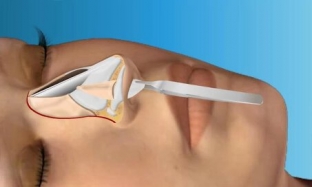Violations in the development of facial structures, including the external nose, are among those congenital pathologies that are often caused by the negative influence of external factors on a woman's health in the first trimester of pregnancy. The formation of the nose occurs approximately at 6-12 weeks of gestation, and under the influence of certain drugs, due to infectious diseases, environmental factors, the intrauterine development of the baby may be disturbed, and anomalies in the development of the shape of the nose may occur. These anomalies are dangerous because they interfere with free breathing and can lead to serious health problems for the child.
Malformations: when the external nose is formed incorrectly
The abnormal development of the external nose can be divided into three groups: agenesis, persistence and dystopia.
The following malformations may occur in agenesis:
- hypogenesis – the nasal concha remains underdeveloped or there are no nasal structures of part of the nose or the entire external nose, the nasal conchas, paranasal sinuses, nasal cartilages are undeveloped;
- hypergenesis – overdevelopment of nasal structures up to doubling of the external nose, overdevelopment of the sinuses, conchas, large cribriform vesicle with obstruction of the excretory openings, excessively long nose or large nasal tip;
- dysgenesis – deformed turbinates, hooked nose, crooked nose with lateral trunks.
Dystopia is characterized by atypical formations in different places of the external nose, for example, a spherical swelling at the anterior end of the turbinate, due to which the olfactory fissure is partially or completely impaired.
Persistence – this is the preservation of such elements of the external nose, which at the time of birth should no longer exist: for example, the presence of median clefts of the nose up to the separation of the halves of the nose from each other, bifurcated turbinates.
Symptoms that determine the anomalies of the external nose
Determination of anomalies in the development of the external nose is carried out in newborns. Some of the malformations are already visible at the initial examination, others are detected later. Symptoms of malformations of the external nose may include the following:
- deformation of the external nose – its excessive development, or the complete absence of structures of the nose, or one inlet;
- food exit through the nasal openings when feeding – happens when the integrity of the nasal cavity is violated;
- cysts in the glabella – occur with congenital fistulas, when their passages are directed upward and go outward at the border between the bone and cartilaginous parts of the nose.
Violation of free breathing through the nose as a symptom of an anomaly of development
- Free breathing may be impaired due to the following malformations of the external nose:
- hypogenesis of the nasal wings, when they are too pliable and prolapse into the nasal cavity;
- hypergenesis of the turbinates, when the patency of the outlet openings in the paranasal sinuses is impaired;
- choanal congestion, when nasal breathing may be impossible at all.
Diagnosis and treatment of anomalies of the external nose
Malformations of the external nose are established not only on the basis of examination of the newborn, but also with the help of instrumental methods – such as radiography, microrhinoscopy, fibroendoscopy, if necessary, computed tomography is done.
Correction of anomalies of the external nose and restoration of free breathing is very important to carry out in a timely manner, since these malformations can lead to inflammation and suppuration with the development of meningitis, to a violation of the formation of the facial part of the skull, and even fatal in case of complete choanal atresia in a newborn.
Congenital malformations of the external nose are treated only surgically. With partial hypergenesis of the tip of the nose, as well as with splitting of the palate in the case of "cleft palate"; plastic surgery is added, and operations to excise frontal-basal fistulas in the area of the back of the nose are carried out with the participation of a neurosurgeon.

Any type of surgical intervention to correct anomalies in the development of the external nose and restore free breathing, according to the timing and volume of the operation, is determined individually for each patient.







Add a comment